Lisfranc Injury
The Lisfranc joint is the point at which the metatarsal bones (long bones that lead up to the toes) and the tarsal bones (bones in the arch) are connect. The Lisfranc ligament is a tough band of tissue that joins bones. This is very important for maintaining proper alignment and strength of the joint.
How May Lisfranc Injuries Occur?
Injuries to the Lisfranc joint may occur in automobile accident victims, military personnel, runners, horseback riders, football players and participants of other contact sports, or something as simple as missing a step on a staircase. Lisfranc injuries occur as a result of direct or indirect forces to the foot. A direct force often involves something heavy falling on the foot. Indirect force commonly involves twisting the foot.
Types of Lisfranc Injuries
There are three types of Lisfranc injuries, which sometimes occur together:
- Sprains. The Lisfranc ligament and other ligaments on the bottom of the midfoot are stronger than those on the top of the midfoot. Therefore, when they are weakened through a sprain (a stretching of the ligament), patients experience instability of the joint in the middle of the foot.
- Fractures. A break in a bone in the Lisfranc joint can be either an avulsion fracture (a small piece of bone is pulled off) or a break through the bone or bones of the midfoot.
- Dislocations. The bones of the Lisfranc joint may be forced from their normal positions.
Symptoms
Symptoms of a Lisfranc injury may include:
- Swelling of the foot
- Pain throughout the midfoot when standing or when pressure is applied
- Inability to bear weight (in severe injuries)
- Bruising or blistering on the arch are important signs of a Lisfranc injury. Bruising may also occur on the top of the foot.
- Abnormal widening of the foot.
Diagnosis
Lisfranc injuries are sometimes mistaken for ankle sprains, making the diagnostic process very important. To arrive at a diagnosis, the foot and ankle surgeon will ask questions about how the injury occurred and will examine the foot to determine the severity of the injury. X-rays and other imaging studies may be necessary to fully evaluate the extent of the injury.
Treatment
Anyone who has symptoms of a Lisfranc injury should see a Podiatrist right away. If unable to do so immediately, it is important to stay off the injured foot, keep it elevated (at or slightly above hip level) and apply a bag of ice wrapped in a thin towel to the area every 20 minutes of each waking hour. These steps will help keep the swelling and pain under control.
Foot pain, no matter how mild, is not natural. If you are experiencing pain or noticing a change in your feet you should seek medical care right away. Early care can help prevent the condition from worsening. Contact Podiatry Group of Georgia today to schedule your appointment or book you appointment online.
Call Our Marietta, Georgia Office Today at 404-806-3731 or Book your appointment online now!

![podiatryGroup-Logo[1] Logo](https://www.podiatrygroupofgeorgia.com/wp-content/uploads/2020/07/podiatryGroup-Logo1.png)
